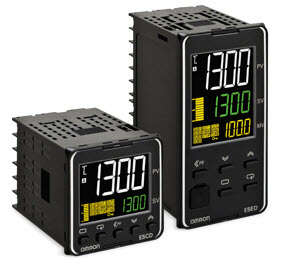Shop by Category
Omron E5-D Temperature Controller
New functionalities enable more precise PID control

In the new E5_D series, we expanded the capabilities of the E5_C series temperature controllers with specialized adaptive control, automatic filter adjustment, and water-cooling output adjustment to open more sales opportunities.
Breakthrough
What problems does adaptive control solve?
To manually recalculate PID parameters requires experienced engineers and hours of downtime. The E5_D has new algorithms to automatically make parameter adjustments during production.
What problems do automatic filter and water-cooling output adjustments solve?
We have reduced human intervention needed to make complex control adjustments to improve product quality while maintaining production throughput. Two new algorithms in E5_D have been added to maintain seal bar temperature in packaging and cooling water temperature in plastics extrusion.
Application Problems Solved with E5_D
Solutions for complex control
Adaptive control helps to maintain optimum temperature control by following any changes that may occur due to system fluctuations, such as changes in the environment or equipment deterioration. With adaptive control, AT (auto-tuning) is required only the first time operation is performed. After that, the equipment startup temperature is monitored to detect system fluctuations and update the PID constants for adaptive control. There is no need to execute AT again or to manually adjust the PID constants, and higher control performance is achieved than is possible with AT alone.
Maintaining seal bar temperature
Packaging: Form-fill-seal machines
Problem: Seal bar temperature drops too low to seal bags properly as speed increases or materials change. This can be caused by too much distance between sensor and heating unit.
Solution: To close the gap between seal bar temperature and control temperature, we developed new E52 sensors designed for direct mounting on the heating unit. Therefore, more accurate input to the controller is processed using a new “automatic filter adjustment function” algorithm that suppresses instability in surface temperature measurements. Fewer variations help keep the sealing bar temperature stable, reducing bad seal failures, waste, and clean-up downtime.
Responding to hot spots in plastics extrusion
Plastics Fabrication: Water-cooled extrusion machines
Problem: As extrusion speed increases, hot spots form near the output head which requires more water to be circulated to cool it down to a temperature where the product is not deformed or damaged. The lag time between when the overheat condition is detected and when the water cools the head sufficiently can result in waste and production shutdown.
Solution: When heat is generated during extrusion molding and water is used for cooling, temperatures vary greatly. E5_D temperature controller takes this into account and includes a “water-cooling output adjustment function.” This constantly detects changes in the temperature and suppresses the variation by automatically adjusting the proportional band (cooling).
Get the Push-In Plus Wiring Terminals Advantage
Save your machine builder up to 60% of wiring effort and costs compared to screw terminals. The E5CD-B and E5ED-B controllers have time-saving Push-In Plus wiring terminals.
.png)

.png)